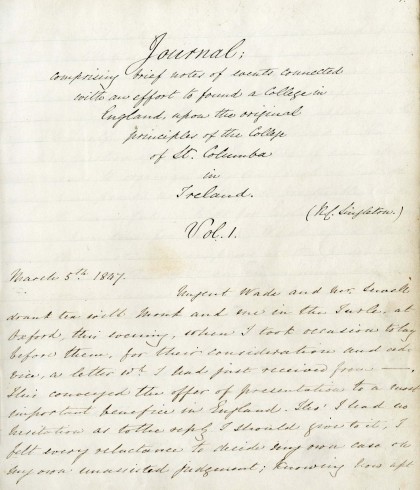Robert Singleton was the first Warden of Radley and has a serious claim (which he himself held) to be considered the co-founder alongside William Sewell. He was one of four present at the inaugural meeting in Turl Street in Oxford on March 5th, 1847, at which the idea of founding a school which would espouse the Christian principles of the Oxford Movement was first mooted. He was appointed Warden in 1847, set up the school, established the first statutes, and donated a considerable part of his own money, but increasing difficulties over Sewell’s view of his own rights as Founder caused Singleton to resign in 1851. At this point the school was on the verge of financial ruin with its reputation seriously undermined by public arguments between Warden and Fellows.
Singleton’s diary appears to have been written as a conscious piece of work for posterity, beginning on the day of the first meeting in the Turl, and continuing until his resignation in October 1851. It was written in a fine copper-plate, characteristic of Singleton’s formal hand as represented in his manuscript of the College statutes, with no apparent hesitation or corrections.
Singleton took the diary away with him when he left Radley College. He kept no other journals after 1851 and appears to have revisited this one only once, in 1874, when he added a codicil condemning Sewell’s extravagant purchases of works of art: “…my studious suppression of every act and fact that I thought was plainly unfavourable to Mr Sewell. Thus I may appear to have sanctioned his purchase of a thousand articles such as pictures, carvings, old furniture, half worn-out carpets etc, vast quantities of which had to be stowed away under the roof of the house…”
He eventually settled at Minster Court, York. He died in 1881. The diary was probably sent to Radley at this time, but its existence went unrecorded until it was ‘accidentally discovered in an old cupboard in 1889.’ In October 1940 the diary was transcribed by A.K.Boyd, notes on it made by Vyvyan Hope, and four copies were typed to be distributed around the country for safety during the Second World War, whilst the originals were deposited in the vaults of the local bank. In 1946, one transcript was lent to St. Columba’s to make their own copy.
Excerpts from the diary were published in The Radleian Magazine in 1947, the centenary of the founding of the College. This will be the first time the diary has been published in its entirety, though some abridged sections have previously been made available online. The plan is for entries to be published on a day-by-day basis as they appear in the diary, with some particularly long entries (such as the very first one) split into two or three parts.
The first sections of the diary were transcribed into electronic form in 2008, and the remaining material is currently being prepared. The transcript is edited by Clare Sargent, and the site is maintained by Andrew Gray, both of Radley College. The explanatory articles, etc, are unsigned, and are mostly written by Clare Sargent with the remainder by Andrew Gray. Contributions, corrections, or requests for expansion are welcome.
Please send enquiries or comments to Radley College Archives, or leave a comment on the relevant entries.

First page of the diary
July 5, 2012 at 9:12 am
This Diary is fascinating and very valuable. I was looking for references to John Radcliffe, Vicar of Radley. Where we read “Ratcliffe” e.g. 6/12/49, 22/10/48, 3/10/48 is that “Radcliffe”? What was Radcliffe’s attitude towards Tractarianism?
July 5, 2012 at 4:09 pm
Thank you. Yes – Singleton uses Ratcliffe and Radcliffe interchangeably. On other occasions he spells the names of individuals phonetically, so Melluish for Melhuish. The transcription has followed his usage. Radcliffe is presented as neither Tractarian nor anti-Tractarian by Singleton but as opposed to the reform of Prayer Book worship and the introduction of choral services. By implication in Singleton’s mind this is almost anti-Gospel. But it should be remembered that Singleton and Sewell were also anti-Tractarian in that they fully supported the reform of services as introduced by the Oxford Movement, but were vehemently opposed to Newman’s conversion to Rome, and distanced themselves from the Movement after the publication of Tract XC. Radcliffe comes across as rather more a typical, early nineteenth century pre-Oxford Movement clergyman, opposing change on principle but he was presented with a revolutionary type of school within his parish and with two characters whom he seems to have profoundly disliked. The choral services, chapel and organ which they introduced were, in Singleton’s and Sewell’s minds, totally in line with Anglican tenets and designed to enhance worship based on the Book of Common Prayer. Yet the school was locally denounced as covertly Roman Catholic. An incident is described when a group of Irish labourers trekked over from Buckinghamshire seeking to hear Mass. Radcliffe also had the problem of Sir George Bowyer, the local landowner, who did convert to Catholicism in the 1850s, and whose land-agent was his friend Grimaldi, an Italian Catholic.